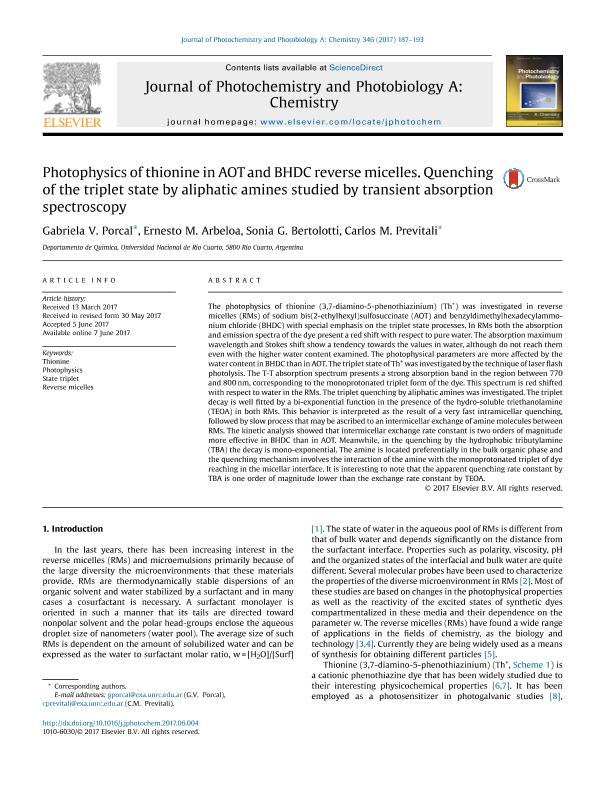Mostrar el registro sencillo del ítem
dc.contributor.author
Porcal, Gabriela Valeria

dc.contributor.author
Arbeloa, Ernesto Maximiliano

dc.contributor.author
Bertolotti, Sonia Graciela

dc.contributor.author
Previtali, Carlos Mario

dc.date.available
2019-05-27T17:33:19Z
dc.date.issued
2017-09
dc.identifier.citation
Porcal, Gabriela Valeria; Arbeloa, Ernesto Maximiliano; Bertolotti, Sonia Graciela; Previtali, Carlos Mario; Photophysics of thionine in AOT and BHDC reverse micelles. Quenching of the triplet state by aliphatic amines studied by transient absorption spectroscopy; Elsevier Science Sa; Journal of Photochemistry and Photobiology A: Chemistry; 346; 9-2017; 187-193
dc.identifier.issn
1010-6030
dc.identifier.uri
http://hdl.handle.net/11336/77218
dc.description.abstract
The photophysics of thionine (3,7-diamino-5-phenothiazinium) (Th+) was investigated in reverse micelles (RMs) of sodium bis(2-ethylhexyl)sulfosuccinate (AOT) and benzyldimethylhexadecylammonium chloride (BHDC) with special emphasis on the triplet state processes. In RMs both the absorption and emission spectra of the dye present a red shift with respect to pure water. The absorption maximum wavelength and Stokes shift show a tendency towards the values in water, although do not reach them even with the higher water content examined. The photophysical parameters are more affected by the water content in BHDC than in AOT. The triplet state of Th+ was investigated by the technique of laser flash photolysis. The T-T absorption spectrum presents a strong absorption band in the region between 770 and 800 nm, corresponding to the monoprotonated triplet form of the dye. This spectrum is red shifted with respect to water in the RMs. The triplet quenching by aliphatic amines was investigated. The triplet decay is well fitted by a bi-exponential function in the presence of the hydro-soluble triethanolamine (TEOA) in both RMs. This behavior is interpreted as the result of a very fast intramicellar quenching, followed by slow process that may be ascribed to an intermicellar exchange of amine molecules between RMs. The kinetic analysis showed that intermicellar exchange rate constant is two orders of magnitude more effective in BHDC than in AOT. Meanwhile, in the quenching by the hydrophobic tributylamine (TBA) the decay is mono-exponential. The amine is located preferentially in the bulk organic phase and the quenching mechanism involves the interaction of the amine with the monoprotonated triplet of dye reaching in the micellar interface. It is interesting to note that the apparent quenching rate constant by TBA is one order of magnitude lower than the exchange rate constant by TEOA.
dc.format
application/pdf
dc.language.iso
eng
dc.publisher
Elsevier Science Sa

dc.rights
info:eu-repo/semantics/openAccess
dc.rights.uri
https://creativecommons.org/licenses/by-nc-sa/2.5/ar/
dc.subject
Photophysics
dc.subject
Reverse Micelles
dc.subject
State Triplet
dc.subject
Thionine
dc.subject.classification
Otras Ciencias Químicas

dc.subject.classification
Ciencias Químicas

dc.subject.classification
CIENCIAS NATURALES Y EXACTAS

dc.title
Photophysics of thionine in AOT and BHDC reverse micelles. Quenching of the triplet state by aliphatic amines studied by transient absorption spectroscopy
dc.type
info:eu-repo/semantics/article
dc.type
info:ar-repo/semantics/artículo
dc.type
info:eu-repo/semantics/publishedVersion
dc.date.updated
2019-05-23T14:40:38Z
dc.journal.volume
346
dc.journal.pagination
187-193
dc.journal.pais
Países Bajos

dc.journal.ciudad
Amsterdam
dc.description.fil
Fil: Porcal, Gabriela Valeria. Universidad Nacional de Río Cuarto. Facultad de Ciencias Exactas Fisicoquímicas y Naturales. Departamento de Química; Argentina. Consejo Nacional de Investigaciones Científicas y Técnicas. Centro Científico Tecnológico Conicet - Córdoba; Argentina
dc.description.fil
Fil: Arbeloa, Ernesto Maximiliano. Universidad Nacional de Río Cuarto. Facultad de Ciencias Exactas Fisicoquímicas y Naturales. Departamento de Química; Argentina. Consejo Nacional de Investigaciones Científicas y Técnicas. Centro Científico Tecnológico Conicet - Córdoba; Argentina
dc.description.fil
Fil: Bertolotti, Sonia Graciela. Universidad Nacional de Río Cuarto. Facultad de Ciencias Exactas Fisicoquímicas y Naturales. Departamento de Química; Argentina. Consejo Nacional de Investigaciones Científicas y Técnicas. Centro Científico Tecnológico Conicet - Córdoba; Argentina
dc.description.fil
Fil: Previtali, Carlos Mario. Consejo Nacional de Investigaciones Científicas y Técnicas. Centro Científico Tecnológico Conicet - Córdoba; Argentina. Universidad Nacional de Río Cuarto. Facultad de Ciencias Exactas Fisicoquímicas y Naturales. Departamento de Química; Argentina
dc.journal.title
Journal of Photochemistry and Photobiology A: Chemistry

dc.relation.alternativeid
info:eu-repo/semantics/altIdentifier/url/https://www.sciencedirect.com/science/article/pii/S1010603017303477
dc.relation.alternativeid
info:eu-repo/semantics/altIdentifier/doi/http://dx.doi.org/10.1016/j.jphotochem.2017.06.004
Archivos asociados
